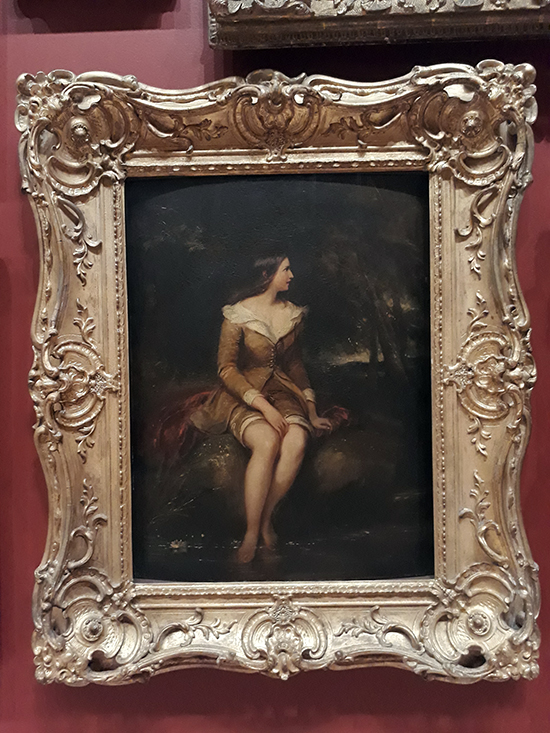Today is a visit to the National Gallery of Victoria, I simply love museums!
The world's largest stained-glass ceiling in the NGV's
Great Hall, designed by Australian artist Leonard French
Leonard French was born in Brunswick, Victoria to a family of
Cornish origin. His stained glass creations include a series of panels in the
cafe and foyer of the National Library of Australia in Canberra, and a stained
glass ceiling for the great hall at the National Gallery of Victoria in
Melbourne, which is one of the largest in the world.
Leonard William French (8 October 1928 – 10 January 2017)
was an Australian artist, known principally for major stained glass works.
"Mary, Lady Vere" (c. 1612-1615) by William LARKIN
how many hundreds or even thousands of the painting of Mary nursing baby, you think exist?
"The Man of Sorrows in the arms of the Virgin" (1475)
{or (1479)} by Hans MEMLING
Originally from a small town near Frankfurt-am-Main, Hans
Memling became a citizen of Bruges in the Burgundian Netherlands in 1465 and
remained there until his death. This panel represents Christ as an image of
pity. Displaying the wounds of his Passion, yet open-eyed and thus ‘alive’,
Jesus is shown cradled in the arms of his grieving mother. Fervent prayer in
front of harrowing images of this type was considered to have the power to
hasten the soul’s passage through the pains of Purgatory.
Piétà (early 16th century) GERMANY
Carved in wood with polychrome surfaces and some gilding. The Pietà (Italian for pity) is a type of devotional
image which developed in Germany at the beginning of the fourteenth century. In
its most common form it depicts, as in this early sixteenth-century example,
the Virgin Mary sorrowfully cradling the dead body of her son Christ.
"Saints Basil, Chrysostom and Gregory with a
kneeling donor" (early 18th century GREECE)
"The Virgin and Child" (mid 15th century-late
15th century) FLANDERS
"Sophonisba receiving the poison" (c. 1675) by Mattia PRETI
"The Town Hall, Amsterdam" (1690) by Gerritt
BERCKHEYDE
"Landscape with cattle" (c. 1639-1649) by Aelbert
CUYP
Aelbert Cuyp is now considered one of the leading
landscape artists of the Golden Age of Dutch painting. The animals in his
landscapes always appear healthy and robust. In their idyllic settings, they
attest to a buoyant Dutch economy and to the sense of prosperity prevalent in
the Netherlands in the early seventeenth century. In particular, the dairy
industry was a subject of great pride, and the depiction of cattle was a
special genre in Dutch painting.
"The Banquet of Cleopatra" (1743-1744) by Giambattista TIEPOLO
The love affair between the Roman consul Mark Antony
(83–30 BC) and the Egyptian queen, Cleopatra (69–30 BC) was a popular subject
for artists in the eighteenth century. The episode represented in Tiepolo’s
painting is drawn from Pliny’s Natural History (written in AD 77). Here Pliny
recounted the tale of a famous contest between the Egyptian and Roman rulers
whereby Cleopatra wagered that she could stage a feast more lavish than the
legendary excesses of Mark Antony.
Tiepolo shows the dramatic moment at the end of
Cleopatra’s repast when, faced with a still scornful Mark Antony, she wins the
wager with her trump card. Removing one of a pair of priceless pearl earrings,
Cleopatra dissolves it in a glass of vinegar and drinks it, thereby causing Mark
Antony to lose his bet. The Banquet of Cleopatra was purchased directly from
Tiepolo’s Venice studio in early 1744, by Count Francesco Algarotti, for
Augustus III, Elector of Saxony and King of Poland. The artist was paid three
hundred zecchini for the painting, which was then dispatched to Dresden (and,
subsequently, to the elector’s hunting lodge at Hubertusburg), remaining in the
royal collections of Saxony until 1765. However, by the turn of the nineteenth
century, The Banquet of Cleopatra had entered the Russian imperial collections,
and was for a time placed on a ceiling within the Mikhailovsky Palace in St
Petersburg. Later it was transferred to the Hermitage Palace, where it remained
until sold to the National Gallery of Victoria by the Soviet authorities in
1932.
on the left: "Monsieur Le Bret and his son, Cardin Le Bret"
(1697) by Hyacinthe RIGAUD
on the right: "Sir Sampson Gideon and an unidentified companion"
(1767) by Pompeo BATONI
The Synnot children (1781) by Joseph WRIGHT of Derby
on the right: "Richard Grenville, 2nd Earl Temple" (1762) by Allan RAMSAY
I am sitting and enjoying "Moses bringing down the Tables of the Law" painting
(1872)-1877 by John Rogers HERBERT
"Dorothea" (1840s) by William ETTY
This painting shows the scene from Cervantes’s tale Don
Quixote in which Dorothea, a fugitive in the mountains, is watched by two of
the Don’s companions as she cools her feet in a brook. She wears a peasant
costume as a disguise and is shown lifting her head at the noise by which the
watchers betray their presence.
Woman in white: "Césarine de Houdetot, Baronne de Barante: Les
Pamplemousses" 1818 by Louise
BOUTEILLER
Iris van Herpen (designer) The Netherlands born 1984. Dress 2011 acrylic,
nylon (tulle), metal
Purchased with funds donated by Norma and Stuart Leslie,
2016
Lamp by Zaha Hadid
Dropping a Han Dynasty urn (2015) by AI Weiwei
it is a plastic on composition board (lego!!!)
Andy Warhol, SELF PORTRAIT NO. 9
###
thank you all for stopping by and viewing the post...
xxx















































